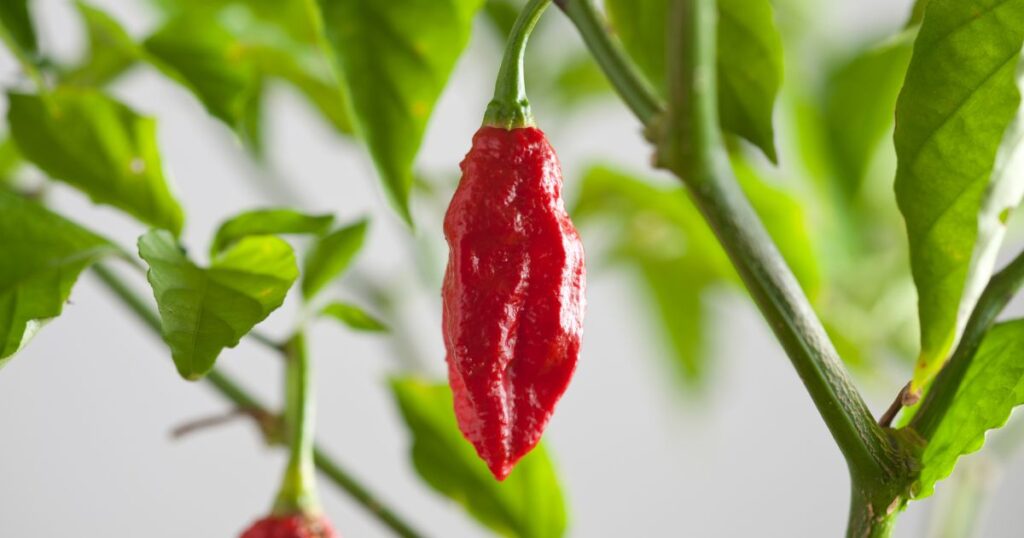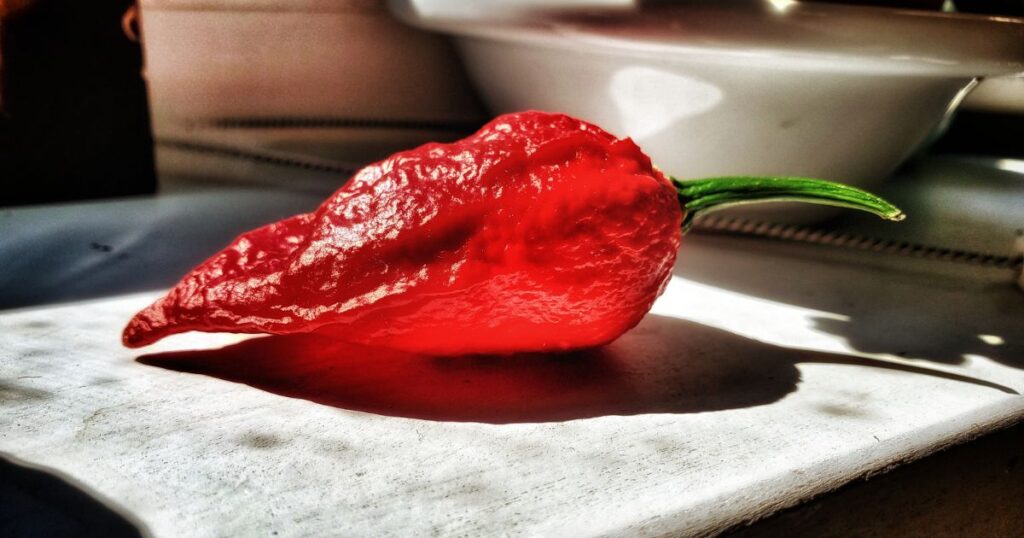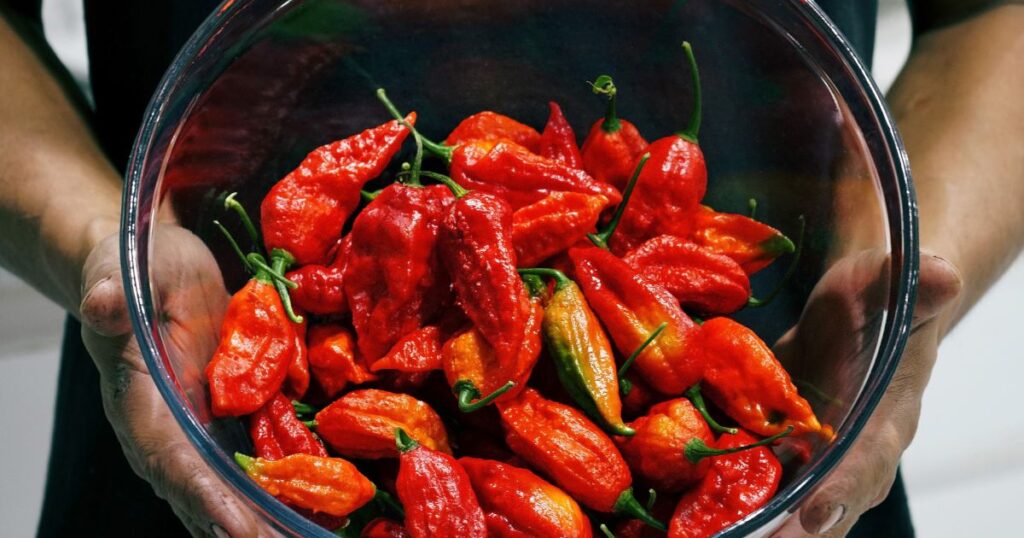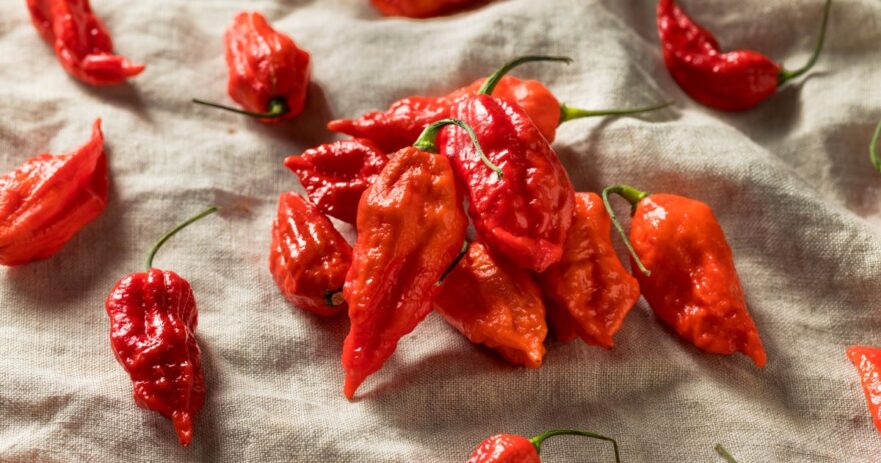In this article about ghost pepper:
🗺️ Origin and history | 🌶️ Uses | ✨ Appearance and taste | 🌶️ Types | 🧑🌾 Growing – gardening | 👨🍳 Cooking – recipes | 🛒 Where to buy | 🫙 How to store | 👨⚕️ Health benefits | 🌶️ Alternatives and substitutes | ❓ Frequently asked questions
What is Ghost Pepper?
The ghost pepper, also known as Bhut Jolokia, is a variety of chili pepper indigenous to Northeast India. When fully matured, these elongated, vibrantly-colored peppers transition from shades of green to intense red, orange, or chocolate brown. Often found in dried or powdered form, ghost peppers are also utilized in their fresh state for making hot sauces, salsas, and other spicy condiments. They are sometimes called Naga Jolokia or ghost chilies.
Ghost peppers are renowned for their exceptional spiciness, registering significantly higher on the Scoville scale than other well-known chili varieties like jalapeños or habaneros. However, despite their remarkable heat, ghost peppers exhibit a distinctly fruity and mildly sweet taste.
| Ghost pepper | |
| SHU | 855,000 - 1,041,427 |
| Median SHU | 948,214 |
| Flavor | Fruity and slightly sweet, with a very intense heat |
| Species | Hybrid of Capsicum chinense x Capsicum frutescens |
| Origin | Northern India |
| Uses | Hot sauces, salsas, curries, pickling, etc. |
Are Ghost Peppers spicy? How hot are they?
Ghost pepper scoville: 855,000 to 1,041,427 SHU
Ghost peppers are notorious for their extreme heat, ranking significantly higher on the Scoville scale than many other chili varieties. Ghost pepper Scoville ratings typically range between 855,000 and 1,041,427 Scoville heat units; for comparison, jalapeños usually register between 2,500 and 8,000 Scoville units. Ghost peppers even more significantly surpass less spicy peppers, like heatless bell peppers (0 Scoville units) and banana peppers, which have a heat level akin to pepperoncini (100-500 Scoville units).
On the other hand, Trinidad Moruga Scorpion and the Carolina Reaper offer even more intense heat levels, surpassing the ghost pepper’s extraordinary spiciness. In addition, chili peppers offer a wide range of heat profiles to suit every preference and palate.
🗺️ ORIGIN AND HISTORY
Where do Ghost Peppers come from?
Ghost peppers, or Bhut Jolokia, are indigenous to northeastern India, specifically the states of Assam, Nagaland, and Manipur. These potent chili peppers have been integral to the region’s culinary and cultural traditions for centuries. Ghost peppers were eventually introduced to other parts of the world, gaining popularity among spice enthusiasts and daring food lovers. Today, ghost peppers are cultivated in India, Bangladesh, and Sri Lanka, further expanding their influence and reputation as one of the world’s hottest chili peppers.

🌶️ USES
What are Ghost Peppers good for? How to use them?
Ghost peppers are incredibly versatile and can be used in the kitchen in numerous ways, providing intense heat and a unique flavor to dishes. They are often incorporated into hot sauces, salsas, and other condiments, adding a fiery kick.
Ghost pepper hot sauces are famous for bringing significant heat to any meal. These sauces can be used as a condiment for tacos and burgers or a dipping sauce for wings. Ghost pepper hot sauces provide heat and impart a fruity, slightly sweet undertone that enhances a dish’s overall flavor.
Ghost pepper salsa is another delicious way to incorporate this chili pepper into your culinary creations. Combining ghost pepper with tomatoes, onions, and other ingredients creates a spicy and flavorful salsa perfect for dipping tortilla chips or topping your favorite Mexican dishes. The intense heat of the ghost pepper pairs well with the acidity of the tomatoes, creating a well-balanced, fiery, and tasty salsa.
A unique way to use ghost peppers is by creating ghost pepper salt. Combining dried, ground ghost peppers with coarse sea salt can produce a spicy seasoning that adds a kick to any dish. This salt can be sprinkled on grilled meats and roasted vegetables or even used to rim the glass of a spicy cocktail.
Ghost pepper wine is an unconventional and intriguing use of these chili peppers. Infusing ghost peppers into wine creates a distinct beverage with a surprising combination of fruity, sweet, and spicy flavors. This daring concoction is perfect for those seeking a new and exciting experience. However, be forewarned that the spiciness of the ghost pepper wine is not for the faint of heart; drinking it straight should be approached with caution and an adventurous spirit.
✨ APPEARANCE AND TASTE
What do Ghost Peppers look like?
Ghost peppers are medium-sized, pod-like, elongated chili peppers with a wrinkled, rough surface. They typically measure between 2 and 3 inches in length and about 1-2 inches in width. The peppers transform color as they ripen, starting as green and turning a vibrant red or orange when fully mature. Their distinct appearance, featuring a pointed tip and thin, crinkled skin, sets them apart from other chili varieties. When dried, ghost peppers have a dark reddish-brown hue and a more pronounced wrinkled texture.
What does Ghost Pepper taste like?
Ghost peppers have an intense, fiery heat and a surprisingly fruity and sweet undertone. The initial taste can be deceptive, as the mild sweetness quickly gives way to a powerful, lingering spiciness. The heat from the ghost pepper builds gradually, reaching its peak intensity after a few moments. Although their extreme heat may not suit everyone, the unique blend of sweetness and spiciness has won over many chili enthusiasts and adventurous eaters who appreciate these peppers’ complex flavor profile.
🌶️ TYPES
What are the different types of Ghost Peppers?
Ghost peppers are available in various colors, each with distinct characteristics. Here, we delve into three unique types: yellow, peach, and purple ghost peppers.
The yellow ghost pepper features a vibrant yellow hue and a fruity, citrusy taste. While still intense, its heat level is slightly milder than the more common red ghost pepper. As a result, yellow ghost peppers work well in dishes with a touch of brightness and a powerful kick, such as salsas, hot sauces, and marinades.
Peach ghost peppers are unique due to their pale orange or peach-colored appearance. They also possess a slightly sweet and fruity flavor while still packing the intense heat of ghost peppers. The peach ghost pepper’s distinctive color and taste make it an excellent choice for adding visual appeal and a fiery punch to various recipes, including spicy jams and jellies.
The purple ghost pepper is a rare variety characterized by its deep purple color, sometimes appearing almost black. This visually striking pepper maintains the extreme heat of its ghost pepper siblings with a slightly earthy and fruity flavor profile. The purple ghost pepper’s dramatic appearance adds an exotic touch to dishes, making it a popular choice for creating a unique and unforgettable culinary experience.
🧑🌾 GROWING – GARDENING
How to grow Ghost Pepper?
Ghost peppers are an exciting option for cultivating. These peppers thrive in warm climates with ample sunlight and can be grown in the ground and in containers. To successfully grow ghost peppers, ensure they are planted in well-draining soil and watered consistently. These peppers also benefit from regular fertilization.
When to pick Ghost Pepper?
Typically, ghost peppers require 120-150 days to reach full maturity (depending on the growing conditions). Therefore, harvesting the peppers regularly is essential, encouraging further growth and yield as they ripen. Though their long maturation period can make ghost peppers challenging to grow, the reward of having homegrown, intensely spicy peppers is well worth the effort for both gardening enthusiasts and chili lovers.

👨🍳 COOKING – RECIPES
Cooking / Recipe ideas for Ghost Pepper
Known for their intense heat and distinct flavor, ghost peppers can be incorporated into various dishes for a fiery twist. One popular use is ghost pepper hot sauce, which adds a powerful kick to everything from tacos to eggs. To make this sauce, blend ghost peppers with garlic, onion, vinegar, and a touch of honey or sugar for a balanced flavor. The result is a versatile and spicy sauce you’ll want to drizzle on all your favorite dishes.
Ghost pepper cheese is another delicious way to enjoy the heat of ghost peppers. Many specialty cheese makers produce spicy cheeses infused with ghost pepper powder, which adds a fiery punch. These cheeses can be added to sandwiches and burgers or served on a cheese platter for an adventurous experience.
Ghost pepper powder is a convenient way to incorporate the heat and flavor of ghost peppers into your cooking. Use it as a seasoning for meats, vegetables, or even popcorn. A little goes a long way, so be cautious when adding it to your recipes.
Ghost pepper jelly is a unique condiment that combines fruit preserves’ sweetness with the ghost peppers’ heat. Spread it on toast, serve it with cream cheese and crackers, or use it as a glaze for grilled meats. Either way, the combination of sweet and spicy will surely please those who love bold flavors.
For an Asian-inspired dish, try making ghost pepper noodles. Toss cooked noodles with a sauce made from soy sauce, sesame oil, ghost pepper powder, and your choice of vegetables or protein. The result is a delicious, spicy noodle dish perfect for a quick dinner.
Finally, ghost pepper wings offer a fiery spin on a classic appetizer. Toss your favorite chicken wings in a sauce made from melted butter, ghost pepper hot sauce, and a touch of honey for a spicy, sticky, and addictive treat. Serve these wings at your next gathering and watch them quickly disappear.
🛒 WHERE TO BUY
Where can I buy ghost pepper?
Ghost peppers can be found either fresh or dried at select grocery stores. Try looking in specialty food stores, ethnic markets, or farmers’ markets if you cannot find them at your local grocery store. You can also purchase ghost peppers online from various websites and deliver them to your doorstep.
When purchasing, choose firm ghost peppers with vibrant colors. Avoid peppers that are soft, shriveled, or have dark spots on them, as they could be past their prime.
In addition to fresh or dried peppers, you can also find various ghost pepper products, such as hot sauces, salts, and powders. You can usually find these items available in the spice or condiment sections of grocery stores or online retailers.
Where can I buy Ghost Pepper plants?
You can purchase your ghost pepper plants from garden centers or nurseries specializing in selling vegetable plants. You can also buy the plants online from various websites.
When choosing ghost pepper plants, look for healthy plants with strong stems and green leaves. Avoid those that look wilted or have yellow leaves, as they could be unhealthy.
Where can I buy Ghost Pepper seeds?
You can purchase ghost pepper seeds online or from a local garden center to grow plants from seed. When planting ghost pepper seeds, follow the instructions on the seed packet and plant them in a location with plenty of sunlight and well-drained soil.

🫙 HOW TO STORE
How do I store Ghost Peppers?
You can keep fresh ghost peppers in the fridge for two weeks. To preserve them longer, put the peppers in a sealed plastic bag or airtight container and place it in your refrigerator’s crisper drawer.
Store dried ghost peppers and products like powders and flakes in a cool, dry area away from sunlight. Use airtight containers to ensure their freshness and avoid moisture contamination.
Can Ghost Peppers be frozen?
Ghost peppers can be frozen. First, clean the peppers and detach the stems. Next, arrange the peppers neatly in a single layer on a baking sheet and freeze them for a few hours. After frozen, move the peppers into an airtight container or plastic freezer bag and store them in the freezer for up to six months.
❤️🩹 HEALTH BENEFITS
Are Ghost Peppers healthy?
Ghost peppers are low in calories but high in fiber, making them nutritious for your diet. They also provide vitamin C, which strengthens the immune system, and vitamin A, essential for maintaining healthy eyes and skin.
Ghost peppers also contain capsaicin, a compound known for its anti-inflammatory and pain-relieving properties. Research has also demonstrated that capsaicin can enhance metabolism and support weight loss.
However, some individuals might experience gastrointestinal discomfort after consuming spicy foods like ghost peppers. Therefore, if you feel discomfort after eating ghost peppers, lessen your intake or avoid them.
Additionally, due to their extreme heat, consuming large quantities of ghost peppers is difficult, meaning that the nutritional benefits may be limited by the small amounts typically consumed.
🔄 ALTERNATIVES AND SUBSTITUTES
What’s a good Ghost Pepper alternative?
Are you searching for suitable ghost pepper substitutes? There are several options available to cater to various heat preferences. For a milder alternative, use habanero peppers; although still spicy, they possess less heat than ghost peppers and work well in sauces and salsas.
Cayenne peppers offer a more moderate heat option with a distinct flavor that can be incorporated into various dishes like curries and stews. Finally, consider serrano peppers to reduce the spiciness further; they can be used in salsas, sauces, and soups while still providing a kick.
For a more versatile, milder choice, jalapeño peppers do well in many recipes. Remember to remove the seeds and membranes to reduce the spiciness. Jalapeños also provide a subtle spiciness that doesn’t overpower the dish, making them an excellent substitute for those who prefer less heat.
How do you pronounce ghost pepper?
The ghost pepper is pronounced gohst PEH-per.
🙋 FREQUENTLY ASKED QUESTIONS
FAQ about ghost peppers
Can ghost peppers burn your skin?
Yes, ghost peppers can cause skin irritation due to their high capsaicin content. Wear gloves when handling these peppers to avoid skin burns or discomfort. In this way, the capsaicin found in ghost peppers is the source of their intense heat; when it comes into contact with your skin, it can cause a burning sensation, redness, or even blisters. It's also essential to avoid touching your face after handling ghost peppers, especially your eyes, nose, and mouth, as capsaicin can cause severe pain and irritation. Washing your hands thoroughly with soap and water after handling ghost peppers can minimize the risk of irritation.
Can ghost pepper kill you?
Although extremely spicy, ghost peppers are unlikely to kill healthy individuals. However, overconsumption may lead to severe gastrointestinal distress and other complications, especially for those with pre-existing conditions.
Can ghost peppers give you diarrhea?
Ghost peppers may cause diarrhea in some individuals, as their intense spiciness can irritate the digestive system, leading to gastrointestinal discomfort. In addition, the high capsaicin content in ghost peppers can also trigger the body's natural response to expel irritants, resulting in diarrhea or other digestive issues. Therefore, it's essential to consume ghost peppers in moderation and be cautious if you have a sensitive stomach or a demonstrated history of digestive problems.
Why the name ghost pepper?
The ghost pepper, Bhut Jolokia, derives its name from the Assamese language. The term "bhüt jolokia" translates to "Bhutanese pepper." Unfortunately, the word "bhüt" was mistakenly associated with the near-homonym "bhut," meaning "ghost." Consequently, the pepper's name was thought to be linked to its intense heat that creeps up on the consumer.
Is ghost pepper hotter than Carolina Reaper?
No, the Carolina Reaper is hotter than the ghost pepper. The Carolina Reaper holds the Guinness World Record for the hottest chili pepper, with Scoville heat units ranging from 1,400,000 to 2,200,000. On the flip side, the ghost pepper is one of the world's hottest, with its Scoville ratings typically ranging between 855,000 and 1,041,427 units.
Is ghost pepper hotter than habanero?
Yes, ghost peppers are substantially hotter than habanero peppers. With a Scoville rating of over 1 million Scoville Heat Units (SHU), ghost peppers greatly surpass the heat level of habanero peppers, which typically register 100,000 to 350,000 SHU. This difference in intensity makes ghost peppers a formidable choice for those wanting a truly fiery experience.
